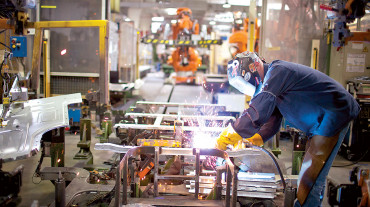Class 8 Orders in January Rise 10% Year-Over-Year

North American Class 8 orders for January hit 17,700, a 9.9% increase from the same period a year earlier, and notching the first year-over-year gain since October 2018.
Some industry analysts see this as the beginning of a welcome calm period after two years of steep highs then deep lows in heavy-duty orders.
In January 2019, Class 8 orders reached 16,105; and for the full year totaled 180,951.
In 2018, January orders were 48,700 and on their way to an annual record of 490,100.
“In 2018, we saw two years’ worth of orders. So it stood to reason that 2019 was going to be soft. So now we are reverting back to normal, or trend, however you want to think about it,” ACT Vice President Steve Tam told Transport Topics.
FTR also pegged the preliminary orders, which will be revised midmonth, at 17,700, or about replacement level.
“From a manufacturing standpoint, lots of times it is not the level, it’s the consistency,” said Don Ake, vice president of commercial vehicles at FTR. “So they can make plenty of money at this rate and drive their costs down because they can manage the business.”
Tam agreed.
“It does get exhausting chasing these peaks,” he said. “There’s no question about that because your sole focus is on keeping up. You can’t do any of the other things that need to be done.”
Clarke
As the market stabilizes, the rest of 2020 will sequentially improve, Navistar International Corp. Chairman and CEO Troy Clarke said during the company’s latest earnings call.
Navistar Inc. makes the International brand of trucks.
“This quarter, we have reduced our backlogs. This will impact our results in the first half of 2020, particularly, first-quarter production volumes.”
The Lisle, Ill-based manufacturer’s fiscal first quarter runs November through January, falling “right on top of the industry’s transition period,” he said.
Tam said a further reading of the latest “data tea leaves” showed the typical decline in orders in January from December was less this year, and cause for some cautious optimism, down 12%, not 20%.
Asked if the cycle is improving again, Tam said, “it is a little bit early to maybe say that. But it is starting to show inklings of moving that direction.”
The latest Class 8 order data landed a day after the Institute for Supply Chain Managers reported economic activity in the manufacturing sector grew in January, and the overall economy grew for the 129th consecutive month. Manufacturing, retail and housing form the base of freight movements.
“The situation is unique,” Ake said. “Freight growth has stalled out at a high level after growing strongly for a couple of years. So there is plenty of freight to haul. Fleets have enough trucks to haul it because they have added so many trucks in response to the rapid growth. Supply of trucks and demand of trucks is balanced. This rarely happens. Usually the market is cycling up or down. Right now, it is stable.”
Preston Feight, CEO of Paccar Inc., said during a recent earnings call, “we make sure that what we’re building has a firm order, a customer name on it, and so we’ve been able to adjust our build rates aligned with our orders and that carries us forward as we look into 2020.”
Feight
Bellevue, Wash.-based Paccar is the parent of the Kenworth Truck Co. and Peterbilt Motors Co. truck brands.
Meanwhile, the effect of coronavirus on production and freight is unknown — though the threat of disruption lurks because of a sick workforce in China where the virus started and millions are quarantined.
Asked about the potential of the coronavirus to disrupt truck makers’ supply chains, Ake said, it was unlikely at this point.
“With demand being reduced, it would be difficult for the coronavirus to cause a huge problem. Not impossible, but difficult for it to be a big factor,” he said.
Managing costs as a manufacturer in this industry is always challenging, Ake added, “and right now, it is relatively easy to do, to rightsize your business and minimize your costs.”
Regarding an extended coronavirus outbreak, Tam said ACT has more questions than answers. “The impact on global and North American economies and transportation is difficult to gauge because the situation is dynamic and fluid.”
He said it is not yet clear, both within China and beyond its borders, what is the reach of coronavirus and ultimately its peak. “There are still uncertainties on its transmission mechanism and whether a cure can be found on a timely basis.”
At this point, ACT has not changed its 2020 North American Class 8 production forecast, “though we have moved some build from first quarter into second quarter,” he said.
It remains at 224,478, down from 342,456 units in 2019.
